A Guide to the New THC and CBD Content Units
The regulations governing the THC and CBD content shown on labels in Canada have changed in January 2021. The main purpose of the change is to help buyers use products in a safe and informed manner.
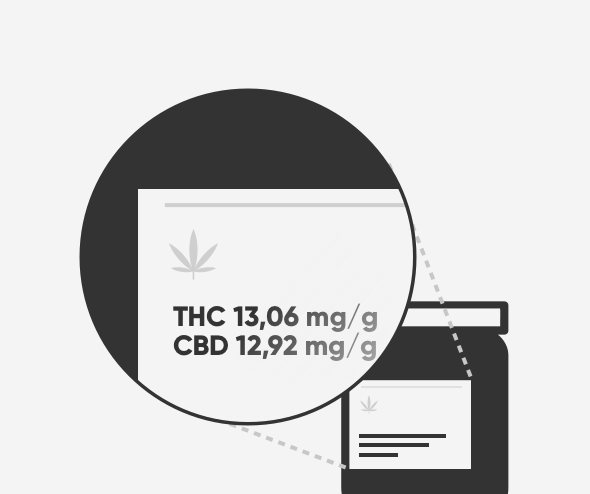
Since early January 2021, all dried and ground flower products as well as all pre-rolls, oils and oil sprays have come in packaging that lists the cannabinoid content in milligrams per gram (mg/g). Capsule packages, on the other hand, list the number of milligrams per unit (mg/unit).
Two things to remember for safe use
1. The number to remember
Milligrams are now THE unit, and novice users shouldn’t consume more than 2.5 mg per session. That’s the figure to remember. If you decide to up the amount consumed, we recommend doing so very gradually.

2. Talk to our advisors and visit our website
If you’re unsure about a product’s THC and CBD content, our in-store advisors can help you figure it out. You can also go to our website and search for the product. The product page for dried and ground cannabis products lists the cannabinoid content as a percentage, a figure we provide to make shopping easier and help ensure low-risk use. For sublingual oils and oral sprays, the content is listed in mg/ml, while for capsules, it continues to be in mg/unit.

Because these changes are rather complicated, we’ve prepared this guide to help you understand them.
There are always two values for THC and two for CBD on the label: A. The first thing to note is that labels still show two values for THC as well as for CBD. The first is the quantity of active cannabinoids contained in the cannabis at the time of purchase. B. The second is the quantity of active cannabinoids contained in the cannabis when it is heated to 150°C or higher. The second figure is the one to look for, because it is the active cannabinoid content when the product is used.
Dried and ground cannabis
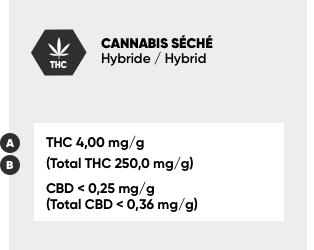
Since cannabis sales were legalized in 2018, producers have listed the THC and CBD concentrations on their product labels as percentages. Beginning January 1, 2021, all products sold at the SQDC have listed the concentration in milligrams per gram. Not to worry though: most producers have also decided to keep the percentage figure on their packaging.
To calculate the percentage based on the new required unit, simply divide the number of milligrams per gram by 10. For example, for a product containing 250 mg/g, divide 250 by 10, which gives 25. This means the product’s total THC content is 25%.
Pre-rolls
The cannabinoid content of pre-rolls used to be expressed in mg/unit or as a percentage. Since the start of 2021, the content unit used in stores is mg/g for the full pack. You can calculate the percentage THC for the full pack or for one unit as explained above: simply divide the number of mg/g by 10.
If you’d like to know the number of milligrams of total THC in, say, a joint from a two-joint pack, here’s the calculation to use: mg/g total THC x the weight of 1 joint = mg total THC in the joint To know the percentage of total THC in the above example, divide the number of mg/g (150 in the example) by 10. In this case, we’re looking at a product with a total THC content of 15%. Remember: the percentage is the same for the whole package and for one unit.
For example, for a 0.5 g joint that comes from a two-joint pack whose total THC content is 150 mg/g: 150 mg/g x 0.5 g = 75 mg of THC in the joint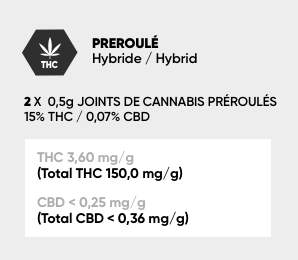
Oils
For oils, the content used to be shown in milligrams per millilitre (mg/ml) but is now listed in milligrams per gram (mg/g).
So, suppose you buy a product with 13.06 mg/g total THC… 1. Check the label for the total THC content per gram In this case, 13.06 mg total THC in 1 gram of oil. 2. Calculate the mg total THC in the container: multiply the mg/g total THC by the net weight mg/g total THC x product’s net weight in g 3. Find the total THC content per ml: divide the mg total THC by the net volume product’s mg total THC ÷ product’s net volume 4. Multiply the total THC per millilitre by the number of millilitres consumed Let’s say you consume 0.5 ml.
Example: 13.06 mg/g x 14.25 g = 186.105 mg THC in the whole container
Example: 186.05mg ÷ 15 ml = 12.407 mg/ml
Total THC content per ml x ml consumed = quantity of THC consumed
Example: 12.407 mg/ml total THC x 0.5 ml consumed = 6.2035 mg total THC consumed
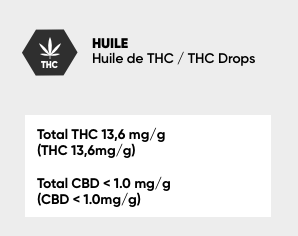
Granted, the calculation is far from simple. But if you go through all the steps, you’ll be able to calculate the total amount of THC and CBD you consume. And if you’re still not sure or don’t feel comfortable doing the math, visit or call a store and ask to speak with one of our advisors.
Oral sprays
For oral sprays, the THC and CBD content is listed in milligrams per gram and milligrams per pump actuation. You can either do the same calculation as for oils or, even easier, just look at the milligrams total THC and CBD per actuation (that’s the number of milligrams delivered by one pump of the spray). Note that each pump actuation provides the equivalent of 0.1 ml of oil.
Remember that a new container has to pumped five to 10 times before its starts working. That’s why, when opening a new container, we recommend pumping it into a glass or the palm of your hand until the oil sprays freely.
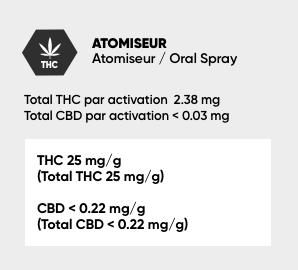
Capsules
No changes here. This means the packaging continues to list the number of milligrams THC and CBD per unit consumed. It’s as simple as that.
Other subjects of interest
Types of product
The SQDC sells a range of quality cannabis products with a lower risk level, all of which have been authorized by Health Canada.
The effects
Relaxing, stimulating and mood-altering: cannabis can have effects that are pleasant or undesirable. Learn what causes the effects and determines how intense they are and how long they last.
Assistance resources
Are you or a friend or family member dealing with a problem related to cannabis use? Several assistance resources are available to you. Take advantage of them!







